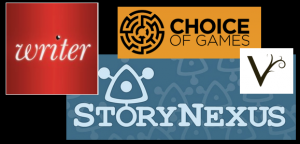Seamless Storytelling

There's been some buzz around interactive stories in the last week, with the launch of the reading-beta of Varytale, the early buzz for Failbetter's StoryNexus platform, and our own inklewriter all hitting the internet within the space of about 48 hours. (And Choice of Games have been accepting new stories for a while now.) It looks a bit like new authors will soon be spoiled for choice. So which way should they go?
The answer is, of course, it depends. Each system has its own system, and each system affords a certain kind of design and a certain kind of storytelling. On the Failbetter blog, Alexis Kennedy has suggested that "StoryNexus is more game-y; Varytale is more book-y", but both are built around the basic idea of "storylets" - little chunks of narrative that are dealt out under certain conditions, like cards in a deck or the flip-flopping chapters of a book like Game of Thrones.
It's a nice model with some nice affordances: writers can add (and subtract) from their deck of plot events in a fairly carefree way, without too much impact on the wider narrative. There's lot of room for additional content, branches built for exploration rather than advancement, and colour. And they can be used repeatedly, to make grind-type stats-based gameplay, in the manner of RPGs.
I think it'd be possible to build the same kind of thing in inklewriter with enough conditionals and paragraphs joined back up to themselves into loop. But it'd be difficult, and the end result wouldn't look right - storylet-style storytelling doesn't just use the idea of separated bits of content, it relies on it as well. The gaps between the end of one piece of content and the start of the next are what allows the writer to work in such a free-form way.
The inklewriter approach
inklewriter sits, then, at the other end of a spectrum. Stories written with our tool are generated as a smooth, endless stream of text (something like this happens inside a Varytale storylet, too). Our goal was "seamless storytelling", of the kind we built for Dave Morris' Frankenstein, and we'll be using again for our next release, from the same author, Down Among the Dead Men.
From the reader's point of view, this seamless style creates a smooth reading experience with no stopping and starting, avoiding that feeling of "lack of direction" that a more gmae-like openness can sometimes conjure up. A good inklebook is like a play, or a tight short story, starting out in motion and then barrelling forward to its conclusion. We wanted to design a tool that built this kind of storytelling into its heart.
Challenges and Rewards
But there are problems associated with it too. The seamless style can make it difficult for an author to make sure the text matches up in a way that always makes sense. Gamebook authors didn't have this problem - in the time between reading page 412 and turning to page 58, most readers would forget the context of the last paragraph, and certainly forget its exact phrasing. In a gamebook there's nothing wrong with:
The man in the hat says quickly, 'Don't forget to knock twice when you get there. You've got to knock twice.'
...followed by...
You arrive at the door. The man in the hat told you to knock twice, so you knock twice.
(Apart from the cheesy writing, that is).
But put that same flow in an inklebook - or a straight piece of writing - and the repetition in the text starts to look clumsy. It grates a little. Just like it would in a story.
Using conditional text
The solution for this is coming in the next big inklewriter update, coming this week, which will add a full suite of conditional logic tools. What that means is, as a writer you can place markers at different places in your story, and then test to see if a reader has passed those markers, and alter what they see based on the results.
That might not sound like much, but it's enough to solve the "man in the hat" problem above. We'd simply set a marker called, well, "Man in the Hat", on the first paragraph of text, and then on the second paragraph - if that marker has been seen - we can change the text from "The man in the hat" to, say, "That man" - or even, "He", if we prefer.
Adapt what you want
There's no cost to introducing markers: inklewriter keeps them indexed and organised for you, so you can use them to track everything from the biggest decisions - (did you accept the job, or turn it down?) - through the medium ones - (did you knock twice, or once?) - to the tiny - (have we mentioned the weather yet in the story?)
You can even track values and count things - how many times has the Juliette read the love-letter? How many clues did Poirot find? But more about that in a later post.
For now, let's just say that with a sprinkling of conditional text, and our elegant approach to presentation, we think inklewriter allows you to produce seamless interactive stories. If that sounds like what you'd like to do, then try it out. If not - well, you're still in luck, but it seems like there's going to be a lot of options out there.